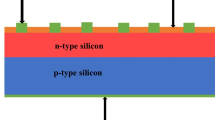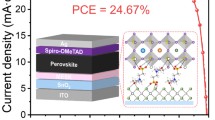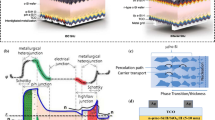Abstract
Plasma hydrogenation is an efficient method to passivate intergrain and intragrain defects of polycrystalline silicon (pc-Si) solar cells. The hydrogenation experiments were carried out in hydrogen plasma generated in an electron cyclotron resonance system controlling different operating parameters such as microwave power (P MW), process time (t H) and hydrogenation temperature (T H) for a fixed hydrogen flux of 30 sccm. The hydrogenation of n+pp+ pc-Si solar cells resulted in an improvement in the open-circuit voltage. The improvement was correlated with the dopant deactivation due to the formation of boron–hydrogen bonding. This was demonstrated from the changes in the doping level after hydrogenation of n+p diode structures made using single crystalline silicon as a reference material. It was found that deactivation of boron was more pronounced at high microwave plasma power, in good agreement with the high open-circuit voltage values obtained on pc-Si mesa cells. On the other hand, the effect of longer hydrogenation time and higher temperature resulted in a decrease of boron deactivation, while an increase in V oc with a tendency of saturation at high T H was observed. Reasons for such behavior were thoroughly explained.








Similar content being viewed by others
References
G. Beaucarne, J. Poortmans, M. Caymax, J. Nins, R. Mertens, Tailored Si-layers on Si oxide obtained by thermal CVD. Proc. Mater. Res. Soc. 485, 89–94 (1997)
G. Beaucarne, J. Poortmans, M. Caymax, J. Nijs, S. Bourdais, D. Angermeier, R. Monna, A. Slaoui, in Recrystallization-Free Thin-Film Crystalline Si Solar Cells on Foreign Substrates. Proceedings of the 2nd World Conference and Exhibition on Photovoltaic Solar Energy Conversion, 1998, pp. 1814–1817
G. Beaucarne, J. Poortmans, M. Caymax, J. Nins, R. Mertens, On the behavior of p–n junction solar cells made in fine-grained silicon layers. IEEE Trans. Electron. Dev. 47, 1118–1120 (2000)
N.H. Nickel, N.M. Johnson, W.B. Jackson, Hydrogen passivation of grain boundary defects in polycrystalline silicon thin films. Appl. Phys. Lett. 62, 3285–3287 (1993)
D. Madi, A. Focsa, S. Roques, S. Schmitt, A. Slaoui, B. Birouk, Effect of MW-ECR plasma hydrogenation on polysilicon films based solar cells. Energy Procedia 2, 151–157 (2009)
D. Madi, P. Prathap, A. Focsa, A. Slaoui, B. Birouk, Effective hydrogenation and surface damage induced by MW-ECR plasma of fine-grained polycrystalline silicon. Appl. Phys. A 99, 729–734 (2010)
P. Prathap, O. Tuzun, D. Madi, A. Slaoui, Thin film silicon solar cells by AIC on foreign substrates. Sol. Energy Mater. Sol. Cells 95, 44–52 (2011)
A. Slaoui, E. Pihan, I. Ka, N.A. Mbow, S. Roques, J.M. Koebel, Passivation and etching of fine-grained polycrystalline silicon films by hydrogen treatment. Sol. Energy Mater. Sol. Cells 90, 2087–2098 (2006)
S.J. Pearton, J.W. Corbett, T.S. Shi, Hydrogen in semiconductors. Appl. Phys. A 43, 153–163 (1987)
S.J. Pearton, in Hydrogen in Semiconductors. Proceedings of 15th International Conference on Defects in Semi-conductors, 1988, pp. 25–30
T. Zundel, A. Mesli, J.C. Muller, P. Siffert, Boron neutralization and hydrogen diffusion in silicon subjected to low-energy hydrogen implantation. Appl. Phys. A 48, 31–40 (1988)
T. Zundel, J. Weber, Dissociation energies of shallow-acceptor-hydrogen pairs in silicon. Phys. Rev. B 39, 13549–13552 (1989)
T. Zundel, J. Weber, Boron reactivation kinetics in hydrogenated silicon after annealing in the dark or under illumination. Phys. Rev. B 43, 4361–4372 (1991)
N.M. Johnson, Electric field dependence of hydrogen neutralization of shallow-acceptor impurities in single-crystal silicon. Appl. Phys. Lett. 47, 874–876 (1985)
R. Rizk, P. de Mierry, D. Ballutaud, M. Aucouturier, Hydrogen diffusion and passivation processes in p- and n-type crystalline silicon. Phys. Rev. B 44, 6141–6151 (1991)
W.B. Jackson, N.M. Johnson, C.C. Tsai, I.W. Wu, A. Chiang, D. Smith, Hydrogen diffusion in polycrystalline silicon thin films. Appl. Phys. Lett. 61, 1670–1672 (1992)
A. Slaoui, P. Siffert, Polycrystalline silicon films for electronic devices, in Silicon: Evolution and Future of a Technology, ed. by E.F. Krimmel, P. Siffert (Springer, Berlin, 2004), pp. 49–72
G. Beaucarne, J. Poortmans, M. Caymax, J. Nijs, R. Mertens, Thin-film structure for photovoltaic. Proc. Mater. Res. Soc. 485, 89–94 (1998)
T. Unagami, T. Takeshita, High-performance poly-Si TFT’S with ECR-plasma hydrogen passivation. IEEE Trans. Electron. Dev. 36, 529–533 (1989)
R.A. Ditizio, G. Liu, S.J. Fonash, Short time electron cyclotron resonance hydrogenation of polycrystalline silicon thin-film transistor structures. Appl. Phys. Lett. 56, 1140–1142 (1990)
E. Hyman, K. Tsang, A. Drobot, One-point numerical modeling of microwave plasma chemical vapor deposition diamond deposition reactors. J. Vac. Sci. Technol. A 12, 1474–1479 (1994)
S.F. Yoon, K.H. Tan, Q. Zhang, M. Rusli, J. Ahn, L. Valeri, Effect of microwave power on the electron cyclotron resonance plasma. Vacuum 61, 29–35 (2000)
C. Herring, N.M. Johnson, C.G. Van de Walle, Energy levels of isolated interstitial hydrogen in silicon. Phys. Rev. B 64, 125209-1–125209-27 (2001)
T.P. Sokrates, Effect of hydrogen on shallow dopants in crystalline silicon. Appl. Phys. Lett. 50, 995–997 (1987)
J.I. Pankove, P.J. Zanzucchi, C.W. Magee, G. Lucovsky, Hydrogen localization near boron in silicon. Appl. Phys. Lett. 46, 421–423 (1984)
N. Fukata, S. Fukuda, S. Sato, K. Ishioka, M. Kitajima, T. Hishita, K. Murakami, Formation of hydrogen-boron complexes in boron-doped silicon treated with a high concentration of hydrogen atoms. Phys. Rev. B 72, 245209-1–245209-8 (2005)
P.J.H. Denteneer, C.G. Van de Walle, S.T. Pantelides, Microscopic structure of the hydrogen-boron complex in crystalline silicon. Phys. Rev. B 39, 10809–10824 (1989)
B. Von Roedern, G.H. Bauer, Material requirements for buffer layers used to obtain solar cells with high open circuit voltages. Mater. Res. Soc. Symp. Proc. 557, 761 (1999)
A.J. Tavendale, D. Alexiev, A.A. Williams, Field drift of the hydrogen-related, acceptor-neutralizing defect in diodes from hydrogenated silicon. Appl. Phys. Lett. 47, 316–318 (1985)
N.M. Johnson, C. Doland, F. Ponce, J. Walker, G. Anderson, Hydrogen in crystalline semiconductors: a review of experimental results. Phys. B 170, 3–20 (1991)
N.M. Johnson, C. Herring, Hydrogen immobilization in silicon pn junctions. Phys. Rev. B 38, 1581–1584 (1988)
T. Yamazaki, Y. Uraoka, T. Fuyuki, Large grain polycrystalline Si thin films by nucleation controlled chemical vapor deposition using intermittent source gas supply. Thin Solid Films 487, 26–30 (2005)
K. Kitahara, S. Murakami, A. Hara, K. Nakajima, Correlation between electron mobility and silicon-hydrogen bonding configurations in plasma-hydrogenated polycrystalline silicon thin films. Appl. Phys. Lett. 72, 2436–2438 (1998)
C.H. Seager, R.A. Anderson, J.K.G. Panitz, The diffusion of hydrogen in silicon and mechanisms for unintentional hydrogenation during ion beam processing. J. Mater. Res. 2, 96–106 (1986)
S.J. Pearton, Hydrogen in silicon unanswered questions. Proc. Mater. Res. Soc. 59, 457–468 (1985)
Acknowledgments
The main author would like to express his thanks to the personnel of the ICUBE (formerly InESS) laboratory for their help and cooperation.
Author information
Authors and Affiliations
Corresponding author
Rights and permissions
About this article
Cite this article
Madi, D., Prathap, P. & Slaoui, A. Role of MW-ECR hydrogen plasma on dopant deactivation and open-circuit voltage in crystalline silicon solar cells. Appl. Phys. A 118, 231–237 (2015). https://doi.org/10.1007/s00339-014-8665-z
Received:
Accepted:
Published:
Issue Date:
DOI: https://doi.org/10.1007/s00339-014-8665-z




